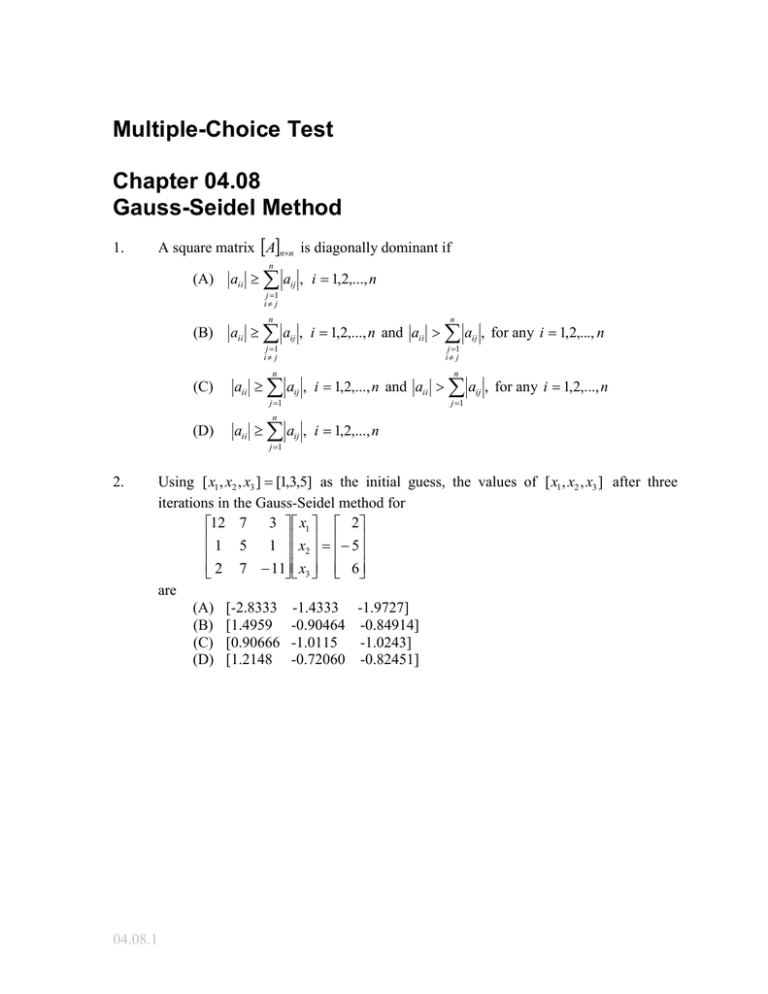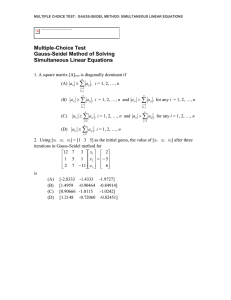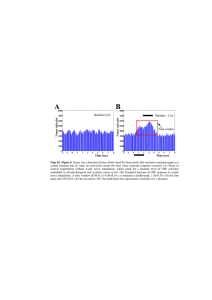Multiple-Choice Test Chapter 04.08 Gauss-Seidel Method
advertisement

Multiple-Choice Test Chapter 04.08 Gauss-Seidel Method 1. A square matrix Ann is diagonally dominant if n (A) aii aij , i 1,2,..., n j 1 i j (B) (C) n n j 1 i j j 1 i j n n j 1 j 1 aii aij , i 1,2,..., n and aii aij , for any i 1,2,..., n aii aij , i 1,2,..., n and aii aij , for any i 1,2,..., n n (D) aii aij , i 1,2,..., n j 1 2. Using [ x1 , x2 , x3 ] [1,3,5] as the initial guess, the values of [ x1 , x2 , x3 ] after three iterations in the Gauss-Seidel method for 12 7 3 x1 2 1 5 1 x 5 2 2 7 11 x3 6 are (A) (B) (C) (D) 04.08.1 [-2.8333 [1.4959 [0.90666 [1.2148 -1.4333 -0.90464 -1.0115 -0.72060 -1.9727] -0.84914] -1.0243] -0.82451] 04.08.2 3. Chapter 04.08 To ensure that the following system of equations, 2 x1 7 x2 11x3 6 x1 2 x2 x3 5 7 x1 5 x2 2 x3 17 converges using the Gauss-Seidel method, one can rewrite the above equations as follows: 2 7 11 x1 6 (A) 1 2 1 x2 5 7 5 2 x3 17 (B) 7 5 2 x1 17 1 2 1 x 5 2 2 7 11 x3 6 7 5 2 x1 6 (C) 1 2 1 x2 5 2 7 11 x3 17 (D) The equations cannot be rewritten in a form to ensure convergence. 4. 12 7 3 x1 22 For 1 5 1 x2 7 and using x1 2 7 11 x3 2 the values of x1 Iteration # 1 2 3 4 x2 x2 x3 1 2 1 as the initial guess, x3 are found at the end of each iteration as x1 0.41667 0.93990 0.98908 0.99899 x2 1.1167 1.0184 1.0020 1.0003 x3 0.96818 1.0008 0.99931 1.0000 At what first iteration number would you trust at least 1 significant digit in your solution? (A) 1 (B) 2 (C) 3 (D) 4 04.08.2 04.08.3 5. Chapter 04.08 The algorithm for the Gauss-Seidel method to solve AX C is given as follows when using n max iterations. The initial value of X is stored in X . (A) Sub Seidel (n, a, x, rhs, nmax ) For k 1 To nmax For i 1 To n For j 1 To n If ( i j ) Then Sum = Sum + a (i, j ) * x( j ) endif Next j x(i ) (rhs (i ) Sum) / a(i, i ) Next i Next j End Sub (B) Sub Seidel (n, a, x, rhs, nmax) For k 1 To nmax For i 1 To n Sum = 0 For j 1 To n If ( i j ) Then Sum = Sum + a (i, j ) * x( j ) endif Next j x(i ) (rhs (i ) Sum) / a(i, i ) Next i Next k End Sub (C) Sub Seidel (n, a, x, rhs, nmax) For k 1 To nmax For i 1 To n Sum = 0 For j 1 To n Sum = Sum + a (i, j ) * x( j ) Next j x(i ) (rhs (i ) Sum) / a(i, i ) Next i 04.08.4 Chapter 04.08 Next k End Sub (D) Sub Seidel (n, a, x, rhs, nmax ) For k 1 To nmax For i 1 To n Sum = 0 For j 1 To n If ( i j ) Then Sum = Sum + a (i, j ) * x( j ) endif Next j x(i ) (rhs (i ) Sum) / a(i, i ) Next i Next k End Sub 6. Thermistors measure temperature, have a nonlinear output and are valued for a limited range. So when a thermistor is manufactured, the manufacturer supplies a resistance vs. temperature curve. An accurate representation of the curve is generally given by 1 2 3 a 0 a1 ln( R) a 2 ln R a3 ln R T where T is temperature in Kelvin, R is resistance in ohms, and a0 , a1 , a2 , a3 are constants of the calibration curve. Given the following for a thermistor R T ohm C 1101.0 25.113 911.3 30.131 636.0 40.120 451.1 50.128 the value of temperature in C for a measured resistance of 900 ohms most nearly is (A) 30.002 (B) 30.473 (C) 31.272 (D) 31.445 For a complete solution, refer to the links at the end of the book. 04.08.2





